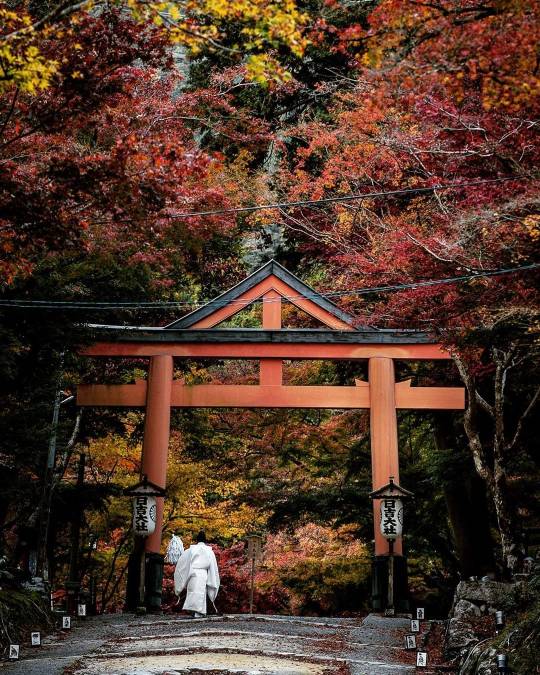#hiyoshi taisha
Text
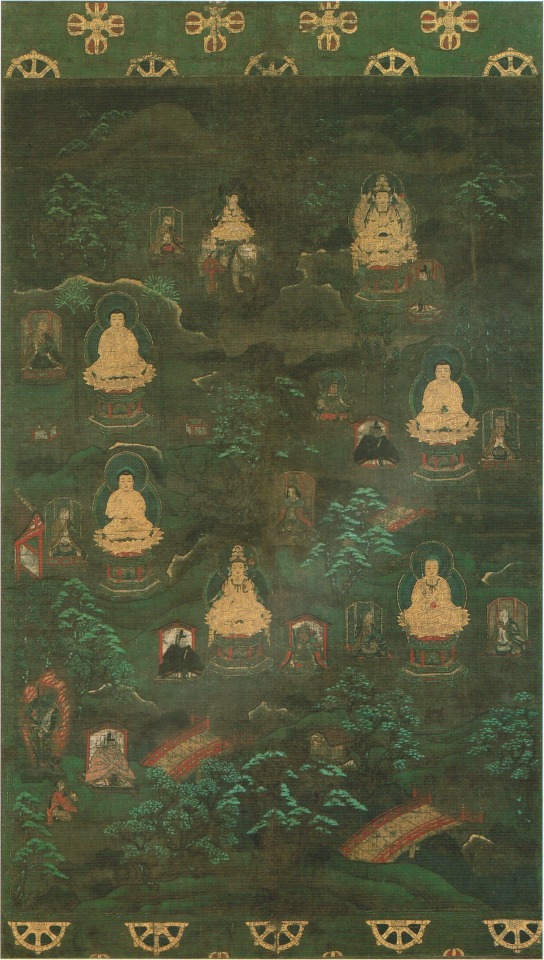
A hanging scroll of the Hie Sanno Mandara (日吉山王曼荼羅), a mandala depicting the local deities of Hie Jinja Shrine (日吉神社), i.e. present-day Hiyoshi Taisha Grand Shrine (日吉大社) in Ōtsu, Shiga Prefecture, as manifestations of the Buddhist divinities of Mount Hiei (比叡山) north of Kyoto, with the deities and divinities matched up throughout the landscape of the mountain
Color on silk dating to the Kamakura period (1185-1333) from the collection of Hyakusaiji Temple (百済寺) in Higashiōmi, Shiga Prefecture
Image from "Shintō: The Sacred Art of Ancient Japan" edited by Victor Harris, published by the British Museum Press. 2001, page 173
#japanese art#buddhist art#曼荼羅#mandala#滋賀県#shiga prefecture#東近江市#higashiomi#百済寺#hyakusaiji#天台宗#tendai#比叡山#hieizan#mount hiei#日吉神社#hie jinja#日吉大社#hiyoshi taisha#日吉山王曼荼羅#hie sanno mandara#crazyfoxarchives#arte budista#arte japonés
26 notes
·
View notes
Text
Japanese Monkey God
User @red-lights-burning asked if there was a connection between Sun Wukong and the monkey gods of Japan. They provided lovely info, which was split between two asks, but I decided to put everything together into a single post.
@red-lights-burning asked:
Japan has their own monkey protector named Masaru AKA Sannō Gongen, who was created back in the early 9th century by Tendai Buddhist sect founder Saichō shortly after he returned from China. So it makes me think if Monkey King was already a thing in the 800’s and if he was one of the inspirations for Masaru.
A description from onmarkproductions (a really great site for anyone curious about Japanese Buddhism and Shintō)
MASARU 神猿
Literally “Kami Monkey.” Masaru is the sacred monkey and protector of the Hie Shrine (aka Hie Jinja 日吉神社, Hiyoshi Taisha 日吉大社). The term “Masura” is often translated as “excel,” reflecting the belief that this sacred monkey can overcome all obstacles and prevail against all evil. Masaru is thus considered a demon queller par excellence (魔が去る・何よりも勝る). In the Heian era, Masaru (also translated “Great Monkey”) was invoked in Kōshin rituals to stop the three worms from escaping the body. Masaru also appears in Japanese scrolls used in Koushin rites.
Here’s a couple other descriptions
SANNŌ GONGEN 山王 権現 SARUGAMI 猿神 Fertility, Childbirth & Marriage
Monkeys are patrons of harmonious marriage and safe childbirth at some of the 3,800 Hie Jinja shrines in Japan. These shrines are often dedicated to Sannō Gongen 山王権現 (lit. = mountain king avatar), who is a monkey. Sannō is the central deity of Japan’s Tendai Shinto-Buddhist multiplex on Mt. Hiei (Shiga Prefecture, near Kyoto). The monkey is Sannou’s Shinto messenger (tsukai 使い) and Buddhist avatar (gongen 権現).
The monkey messenger is also known as Sarugami (猿神; literally “monkey kami”). Sarugami is the Shinto deity to whom the three monkeys (hear, speak, see no evil) are reportedly faithful. The monkey shrine at Nakayama Shrine 中山神社 in Tsuyama City, Okayama Prefecture, is dedicated to a red monkey named Sarugami, who blesses couples with children. According to shrine legends, the local people at one time offered human sacrifices (using females) to this deity. The shrine is mentioned in the Konjaku Monogatari-shu (今昔物語集), a collection of over 1000 tales from India, China, and Japan written during the late Heian Period (794-1192 AD). Sarugami, like Sannou Gongen, is also worshipped as the deity of easy delivery and child rearing. At such shrines, statues of the monkey deity are often decked in red bibs -- a color closely associated with fertility, children, and protection against evil forces and diseases like smallpox.
My answer:
I've read only a little bit about Japanese monkey gods. I previously referenced Sarugami in my article about the possible shamanic origins of primate-based boxing in China. Part of footnote #14 reads:
In Japan, monkeys were also associated with horses and healing via the warding of evil. Apart from monkeys being kept in stables like their Chinese counterparts, their fur was applied to the harnesses and quivers of Samurai because the warriors believed it gave them more control over their mounts. Furthermore, monkey body parts have been consumed for centuries as curative medicines, and their hides have even been stuffed to make protective amulets (kukurizaru) to ward off illness. Likewise, a genre of painting depicts divine monkeys (saru gami), messengers of the mountain deity, performing Da Nuo-like dances to ensure a good rice harvest (Ohnuki-Tierney, 1987, pp. 43-50)
The aforementioned article suggests a connection between monkeys and the Shang-Zhou Da Nuo (大儺 / 難; Jp: Tsuina, 追儺) ritual, an ancient, war-like, shamanic animal dance designed to drive away demonic illness and influences. The pertinent section reads:
It’s possible that the “twelve animals” of the Da Nuo exorcism refer to some precursor of the Chinese zodiacal animals (rat, ox, tiger, rabbit, dragon, snake, horse, goat, monkey, rooster, dog, and pig). If true, monkey fur could have been among the animal products worn by the ritual army. After all, monkeys have long been associated with curing illness and expelling evil in East Asia. [14] A modern example of exorcists who don monkey fur are the shamans of the Qiang ethnic group of Sichuan. The Qiang worship monkeys as the source and savior of their sacred knowledge, as well as the progenitor of their people, the latter being a myth cycle common among ethnic groups of Tibet and southwestern China.
This is the only relevant info that comes to mind. But based on what I know, I would guess that Sun Wukong and the monkey gods of Japan draw upon the same cultural sources. I hope this helps.
Source:
Ohnuki-Tierney, E. (1987). The Monkey as Mirror: Symbolic Transformations in Japanese History and Ritual. Princeton: Princeton University Press.
#asks#Sun Wukong#Monkey King#Journey to the West#JTTW#Japanese Buddhism#Shinto#Buddhism#monkey god#shamanism#Lego Monkie Kid#LMK
72 notes
·
View notes
Text
The list of real-life places related to series I love that I have managed to visit this year keeps on growing.
Yesterday, I went to Shiga, the prefecture where Donten ni Warau is set in. I visited Oumihachiman with a friend, which in my opinion is the best place to have a taste of how life was back then.
We left the town planning to come back and visit the ninja village in Kouka, which isn’t too far from it. We might also visit Hikone and Samegai-juku while we’re at it.
A decade after getting into the Warau series, I finally understand why Karakara-sensei decided to create this story. It was begging to be told. Everything in Oumihachiman oozes the aura of Donten.
My friend and I will probably be going to the Kouka Ninja Village in spring. We’ll also be going to Otsu to see Hiyoshi Taisha, Shirahige Jinja and the Karasaki Shrine, which the Kumou Shrine is based on.
14 notes
·
View notes
Text
Shinshi (Divine Servant)
The link did not include the chart, but I found one on the Japanese Wikipedia and machine translated it. The translation is below.
animal God
mouse Daikokuten
cow Tenmangu Shrine * See Tenjin Faith
tiger Chogosonshiji Temple
bee Futarasan Shrine
rabbit Sumiyoshi Taisha Shrine / Okazaki Shrine / Toshi Shrine
turtle Matsuo Taisha Shrine
crab Kotohira Shrine
eel Mishima Taisha Shrine
snake Benzaiten・
sea serpent Izumo Taisha Shrine
white snake Suwa Shrine Omiwa Shrine
fox Inari Shrine * See Inari God .
deer Kasuga Taisha Shrine / Kashima Shrine
monkey Hiyoshi Taisha Shrine / Asama Shrine
crow Kumano Sanzan , Itsukushima Shrine
crane Suwa Taisha Shrine
pigeon Hachiman Shrine
heron Kehi Shrine
chicken Ise Shrine , Atsuta Shrine , Isonokami Shrine
wolf Shrines in the Okutama / Chichibu region such as Musashi Mitake Shrine and Mitsumine Shrine
carp Omae Shrine
boar Go'o Shrine / Wake Shrine
centipede Bishamonten
Here is a link to the original text.
#Japanese Mythology#Animal#Shinshi#Divine Servant#Shinto#Mouse Spirit#Cow Spirit#Tiger Spirit#Bee Spirit#Rabbit Spirit#Turtle Spirit#Crab Spirit#Eel Spirit#Snake Spirit#Sea Serpant Spirit#Fox Spirit#Deer Spirit#Monkey Spirit#Crow Spirit#Crane Spirit#Pigeon Spirit#Heron Spirit#Chicken Spirit#Wolf Spirit#Carp Spirit#Boar Spirit#Centipede Spirit#Animal Spirit
4 notes
·
View notes
Note
👍Why not Shou and Nazrin!
A Shared Headcanon
To show appreciation for all of Nazrin's hard work, (and possibly to keep her from eating all the stone statues and scrolls around the temple when upset) Shou had a second "Nezumi no Hokura" like the one at Hiyoshi Taisha built just down the road from Myouren.
She told Nazrin it faced Enryaku-ji defiantly like the original, but inside the border of Gensokyo it is hard to tell. It is the thought that counts and it has kept Nazrin appeased for now.
#ask meme#momigeddon#muse: nazrin#I need to finish her profile but my Nazrin is based on Tesso the Iron Rat
0 notes
Text
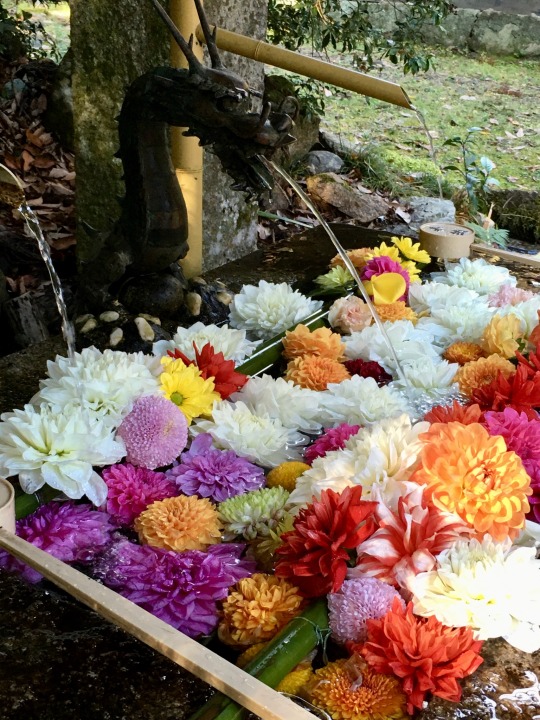
Hiyoshi Taisha, Otsu city 🌸🍁
#japan#japan photography#japan photos#owlet’s photos#i went from here up to mt hiei to see the leaves today and it was incredible#but altitude sickness struck which i need to mitigate because i want to go back#when it snows#shiga#otsu#kyoto#hiyoshi taisha
100 notes
·
View notes
Photo

Various pictures of the many autumn spots of Hiyoshi Taisha (日吉大社) in Ōtsu City, Shiga Prefecture, Japan.
53 notes
·
View notes
Photo

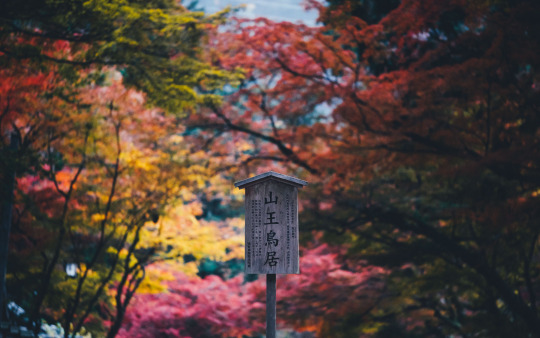






Shiga, Japan
Kyu-Chikurin-In | Hiyoshi Taisha
7K notes
·
View notes
Text
Speaking of Nobu and gods. He really seems like he just doesn’t like the Buddhist sects, but he kind of has a “just in case” attitude with the Shinto gods for quite a while.
‘Cause like... he... kind of regretted Hieizan, you know? Sort of. Some time after he razed Enryakuji on Hieizan, he went and asked a Shinto priest like “I burned the mountain, do you think something bad would happen to the capital?” The priest said “So far there’s been no records of bad things happening just because something went wrong on Mount Hiei”, so Nobu was like “Oh okay then”.
He didn’t regret Enryakuji, no. It’s the mountain that he was worried about, because superstitions that the mountain is a barrier against demons/bad luck. Also, there’s a Hiyoshi Taisha in the mountain that got burned as collateral damage, so there’s that. “Hiyoshi Taisha” is the shrine of the mountain god. It’s so funny because it’s not really relevant to Hideyoshi.
Although, because it has a name like that, legends say that Toyotomi supporters use this shrine as a cover to worship the Toyokuni Daimyoujin (Hideyoshi) during the Anti Toyotomi crackdowns under the Edo bakufu. But well, in Nobu’s time it’s really not connected to Hideyoshi TBH.
Not entirely sure when he eventually just stopped caring about deities altogether. Frois’s writings can be a bit ????? sometimes, so I’m being careful with it. I always worry that he had misunderstood something due to culture miscommunication or him taking hyperbole too seriously.
5 notes
·
View notes
Text
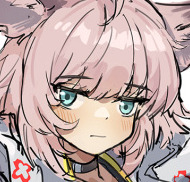
Notes:
- Vessel is attuned to aether of Wind and Water.
- Vessel can summon Ofuda and etch upon them.
- Vessel is short and suffers mutations that have grown it fox ears and a tail.
- Vessel is almost clinical in how it addresses their job.
- Vessel has adept knowledge of Hiyoshi Taisha despite never visiting.
5 notes
·
View notes
Text
Anatomy of a Shintō Shrine
Hello! Shinto shrines have a generally recognizable structure that may be confusing to some, so I will explain a typical shrine layout.
鳥居 Torii: Torii are the gates at the entrance of a shrine, sometimes followed by a path leading up to the shrine itself. It marks that the land behind it is holy. Torii can also be within shrine grounds. They can be of varying sizes and material, and usually are the materials’ natural color or crimson.

手水舎 Chouzuya: A Chouzuya is where you purify your hands and mouth. You use these hishaku scoops to scoop water from the basin.
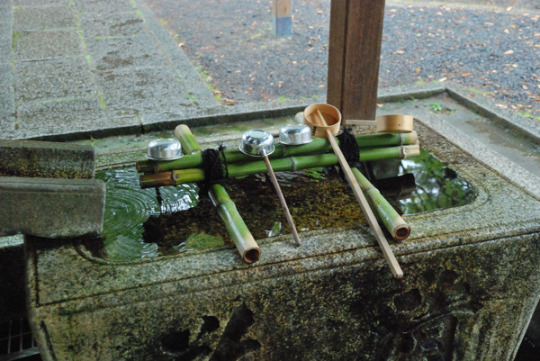
Pictured: Shimogoryo Jinja’s Chouzuya
There is a generally accepted specific procedure for using a Chozuya. Though purification is important in Shinto, this specific procedure and Chozuya in general are only for a shrine context. This sign is commonly seen at shrines:

Right to left, top to bottom it says to wash your left hand first, then your right, cup some water in your left hand and rinse out your mouth. Of course, you must not spit into the basin since people after you will use it too. I’ve often seen variations of this poster where worshippers are asked to lean the hishaku back so that the water cleans the handle, like so:
本殿 Honden: The honden is the main shrine building, where the kamisama is enshrined. It’s usually the largest on the shrine grounds. You cannot step foot within the building. Instead, you pray at the front. Some shrines have signs asking visitors not to take photos of the inside. Please respect those signs.

Pictured is Hiyoshi Taisha’s Higashi Hongu Honden.
お賽銭箱 Osaisen-bako: This is the box for monetary offerings. I grew up being told it was rude not to offer any money. Generally speaking, though, shrines are very dependent on money offerings for upkeep, maintenance etc. and more money is considered better. This is especially true for regional/rural shrines.

摂社 Sessha, and 末社 Massha: Smaller shrines to a different kamisama, which are affiliated with the shrine whose grounds they are on. They are usually there because the kamisama is in some way related to the gosaijin (enshrined kami) of the honden, such as being the child of the gosaijin. One shrine may have multiple sessha/massha. The distinction between sessha and massha is quite confusing and can vary by shrine as it was different pre-WWII.

Pictured: Umaji Isobe Jinja’s Sessha/Massha
授与所 Juyojo: Building where talismans/charms and fortunes are offered. Though shrines can be visited at any times, juyojo have hours of operation as they are staffed. You do not buy charms or ofuda, you offer money in exchange for the item or service.

Pictured: Samukawa Jinja’s juyojo
*This is a general post, so there are exceptions for the naming conventions.
90 notes
·
View notes
Photo
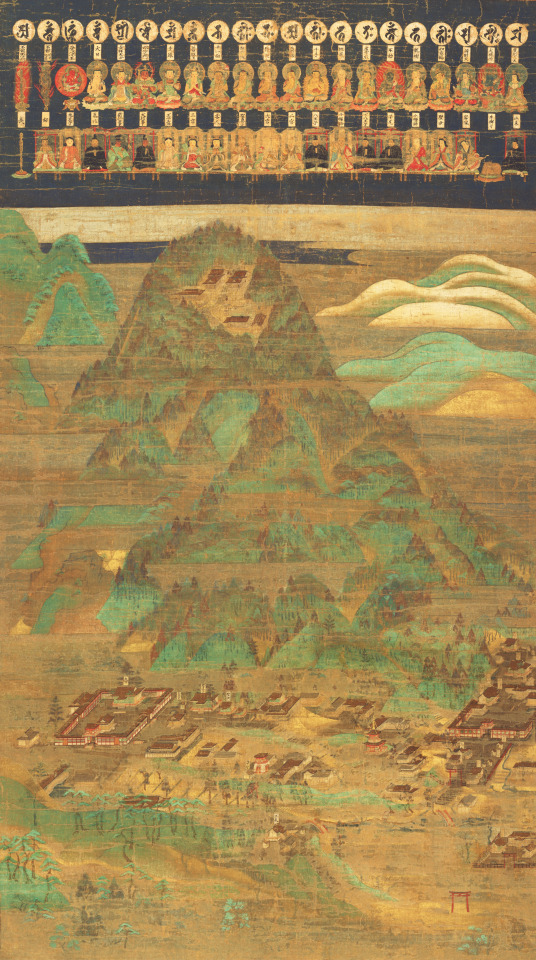
A hanging scroll of the Hie Sanno Miya Mandara (日吉山王宮曼荼羅), a mandala depicting the local deities of Hie Jinja Shrine (日吉神社), i.e. present-day Hiyoshi Taisha Grand Shrine (日吉大社) in Ōtsu, Shiga Prefecture, as manifestations of the Buddhist divinities of Mount Hiei (比叡山) north of Kyoto, with the deities and divinities matched up above and the two institutions situated geographically below
Ink and color on silk dating to the late 14th century, from the collection of the Nara National Museum
#japanese religion#japanese art#buddhist art#曼荼羅#mandala#滋賀県#shiga prefecture#大津市#otsu#近江国#omi province#比叡山#hieizan#mount hiei#日吉神社#hie jinja#山王権現#sanno gongen#日枝大社#hie taisha#日吉大社#hiyoshi taisha#日吉山王宮曼荼羅#hie sanno miya mandara
30 notes
·
View notes
Photo

at Hiyoshi Taisha, Otsu ©shinji aratani
637 notes
·
View notes
Video
youtube
哲学の道 2021年京都の桜 大豊神社 Philosopher's Path: Kyoto's Cherry Blossoms in 2021 Otoyo Shrine
哲学の道
哲学の道は「日本の道100選」に選定されています。若王子(にゃくおうじ)橋から銀閣寺橋まで続く疏水沿いの約2kmの散策道に約400本のソメイヨシノなどが咲き誇ります。この時期、満開の桜のトンネルが絶景! 大豊神社 狛ねずみが鎮座する神社。 向かって右側のねずみは学問を象徴する巻物を、左側のねずみは、万物の根源である水玉を抱えています。祭神として祀られているのは、出雲大社の祭神としても知られる大国主命。 本殿に向かって左奥には、火難除の愛宕社と災難除の日吉社の祠が並んでいます。向かって右側に災難除「日吉社」狛猿、左側には火難除「愛宕社」狛鳶が鎮座しています。 本殿の左右に狛蛇も鎮座しています。以前は狛黒蛇が本殿左横の石の上に鎮座していましたが、本殿前(向かって左側)に移転していました。そして狛白蛇が向かって右側に新たに鎮座していました。金運にご利益がありそうですね。 そして、本殿前にある枝垂れ桜が満開を迎えており、見事な光景でした。時期によっては右側に枝垂れ梅もあり、両方の共演が見られるそうです。 哲学の道を訪れた際はこちらの大豊神社へのお参りもおすすめです。
The Philosopher's Path
The Philosopher's Path has been selected as one of the 100 best paths in Japan. About 400 Someiyoshino and other cherry trees are in full bloom along the 2km long path along the Sosui Canal from Nyakuoji Bridge to Ginkakuji Bridge. At this time of year, the tunnel of cherry blossoms in full bloom is spectacular! Otoyo Shrine A shrine with koma nezumi (guardian mice). The mouse on the right side of the shrine holds a scroll symbolizing learning, while the mouse on the left side holds a water ball, the root of all things. The deity enshrined here is Okuninushi-no-mikoto, also known as the deity of Izumo Taisha. On the far left facing the main shrine are the shrines of Atago Shrine, which protects against fire, and Hiyoshi Shrine, which protects against disaster. On the right side of the shrine are the Hiyoshi Shrine koma-mon (monkeys) to ward off disasters, and on the left side are the Atago Shrine koma-toi (steeplejack) to ward off fire. Koma-snake (guardian snakes) sit on either side of the main shrine. In the past, these guardian black snakes sat on a stone next to the left side of the main shrine, but they have been moved to the front of the shrine (on the left side). The white koma snakes were newly placed on the right side. It seems to be beneficial for money luck. The weeping cherry trees in front of the main shrine were in full bloom, and it was a beautiful sight. Depending on the time of year, there are also weeping plum trees on the right side, and you can see both together. If you visit the Philosopher's Path, I recommend paying a visit to this Otoyo Shrine.
0 notes
